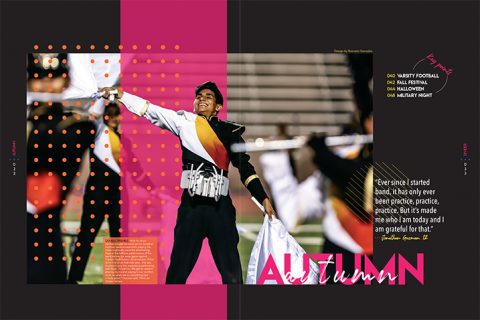The process of covering one year of the high school experience is the most challenging and rewarding part of the yearbook creation process. Before the new school year even begins, the editors and staff must determine what they think will be the most crucial events, groups, sports, clubs and people that need to be covered. They also must determine in what sequence these topics and events need to be placed in the book and how many pages should be allotted to each.
A skilled group of editors will develop a coverage plan that directly relates to the character of the year and ties to the flow and focus of your theme. They will also develop a method to find the stories that have not even been thought of yet. So many amazing, unforeseen things happen every year, and a great staff must be prepared to find them, cover them and determine a place in the book for them.
If you had unlimited pages and a limitless budget, not to mention a large enough staff, you could cover what happens at your school every day of the year, but no one really wants to create a 700+ page book. So you must work within the resources available to maximize all that you do cover with words, photographs and contemporary design.
Various coverage approaches are used to organize the pages and topics within your yearbook. While this article is meant to focus on chronological, I do want to briefly visit the two other most common approaches – traditional and umbrella – so you have a better understanding when I advocate for chronological.
Traditional
Traditional yearbook coverage divides events and topics into specific sections. It is the most common approach and has been used as far back as the 1930s and 1940s. The typical sections are student life, sports, academics, people/mugs, clubs/organizations and ads.
Pros: This structure is the most common and most familiar to your reader. It allows you to allocate spread space and content to traditional groups, events and activities.
Cons: This approach can put you in a rut if you use it every year — same events, same sports, same people. It may force you to give coverage to a team, club or event that really does not have a compelling story that year, while making it difficult to find a place for stories that don’t fit into one of those predetermined sections. Also, you have to consider how to cover events that combine groups, such as homecoming, which involves sports, student life and clubs.
Umbrella
This method organizes the stories according to specific, often theme-related “umbrella” topics, rather than traditional topics such as homecoming, football or math class. Spreads focus on a topic like “pride” or “fun,” or you might reorganize your entire book around specific topics as your major sections. At its core, umbrella coverage is driven by word play and is most effective when it connects directly with your theme.
Pros: This method lets you mix different kinds of stories that would normally be in separate section of the book on a single spread. This is particularly helpful for certain topics, like the homecoming example I mentioned that involves sports, student life and club/organizations, that may fall into more than one traditional coverage section categories.
Cons: Sometimes the connections feel forced, and it’s difficult for the reader to understand why such different types of information have been grouped together.

Chronological
The chronological coverage approach organizes the book by events of the year as they happen. This structure could be by week, month, season or semester, or you could organize by event or topic in the order they occur. Chronological coverage allows you to mix types of coverage on each spread. For example, you might cover a club event, an academic activity and a game that happen during a specific week all on the same spread.
This may sound daunting if you’ve never done a chronological yearbook before, but you have more experience than you think if you also teach newspaper. The newspaper, whether printed or online, tells the story of the year in chronological order, determining the most relevant and important stories to tell as they happen. Within their allotted time frame – weekly, biweekly, etc., they decide how much space to give each story and make photo assignments. They plan some stories in advance knowing events coming up, may have human interest stories that are not as time specific and choose other stories as they find them.
Consider these varied approaches to chronological coverage:
Mixed Topic Weekly/Monthly Chronological – organized by a set time frame
In this chronological method, the structure of spreads is based on a specific time frame (for example, one spread per week or one spread for multiple weeks). To take this on, you must be very organized and methodically prepared to find stories to fill each spread.
Organic Chronological – organized by topics in chronological order
In this method spreads are usually about a single topic and organized as they occur. Back to school in August, Halloween in October, Holiday can drive in December. Fall sports could be placed when the season ends – Fall sports in November or December. Winter sports in February or March, Spring sports at the end of the book.
Blended Chronological – organized by a blend of both chronological order and traditional sections
The overall structure of the book is chronological, but you can add traditional and focused sections throughout the book. For example, along with the month by month coverage, you could add a separate sports section in chronological order. Some schools choose chronological seasons, and then each season is organized by traditional sections. Most books will add a people section as its own separate section outside of the chronological order, but you can also distribute each set of class portraits throughout the book.
Pros: This approach allows you to cover more topics in more creative ways. You can find topics for coverage that normally would never get any coverage. This approach works best when there is a reason to do it (like a national pandemic where schools are starting back in a variety of unique ways). Chronological coverage works best when it connects and relates to your theme. This approach forces you to find story ideas as they happen and provides a place and sequence for them.
Cons: To pull off weekly chronological coverage, the staff must be organized and have a system in place that helps you find stories and then cover them nearly every day. Once you miss a story in this method, you can never get it back. Successful schools have developed teams that work in a week-by-week rotation. Each team is responsible to cover whatever needs to be covered in that specific period of time. Also, your plan needs to reflect that some weeks will have less coverage than others.

Why chronological now?
As the new school year approaches, many advisers and staffs are considering making the switch to a chronological organization of their content. Others who are used to organizing the traditional way by sections are a little nervous about stepping into the unknown. From my point of view, for this specific year, CHRONOLOGICAL IS THE ONLY WAY TO GO. Here’s why:
Reasons for Chronological:
- The unknown nature of this year. We may not know far enough ahead what events will happen as the year unfolds. When will sports happen? Will they happen at all? What will club activities look like? What events and activities do we want to expand our coverage of? Chronological coverage gives staffs the opportunity to cover any and all important parts of the year as they happen.
- Allows for new creative approaches to coverage. You will be able to focus in more depth and detail on individual students and topics you may not have had space for in previous years.
- Flexibility. Monthly sections can expand or contract based on what happens. September may only have 10 spreads while January may need to expand to 20 or more.
- It’s true journalism. As yearbook journalists, it will be our mission to know the pulse of the student body and the community and find and report the story as it happens.
- It will be an exciting adventure. Finding and covering this year will be a little like a treasure hunt. What stories can we find that we had no idea would be there when the year began? Even though there is uncertainty, the reward will be rich. This book will be like no other in the history of your school, and every student should want a copy.
Concerns About Chronological Coverage:
- Creating a ladder. The ladder will probably not be as complete and what exactly will go on each spread may not be as specific as you are used to, but you can block out pages for each month, semester or season.
- Too many unknowns. Yes, a lot is unknown as the 2021 year begins, but you and your staff will meet the challenge as it comes. In the end, you will have created a historic document about this crazy, unique year. Talk about great job skills experience!
Whatever you and your staff feel is the best method for you is going to produce a one-of-a-kind, historic record of this moment in time. Embrace the unique opportunity this presents for valuable, hands-on training and job skills for your students to use in their future careers.
Video Examples
You can learn even more about chronological coverage in these helpful videos! Video one is a general overview of a chronological yearbook.
Video two follows Davie County High School from Mocksville, North Carolina, through their chronological yearbook coverage.
Video three follows Silver Creek High School from San Jose, California, while also highlighting spreads and features that could be captured using crowdsourcing, like with Yearbook Snap.





